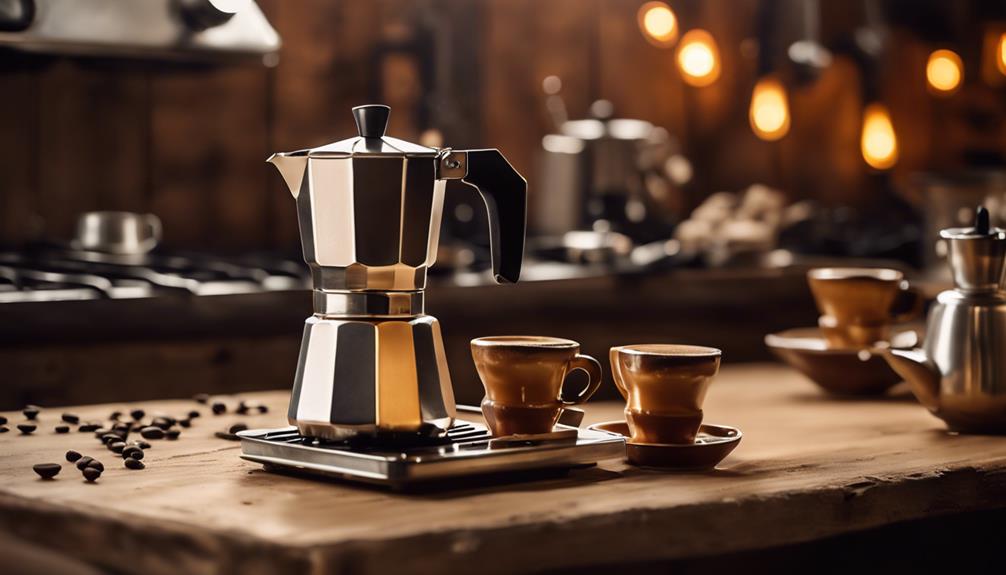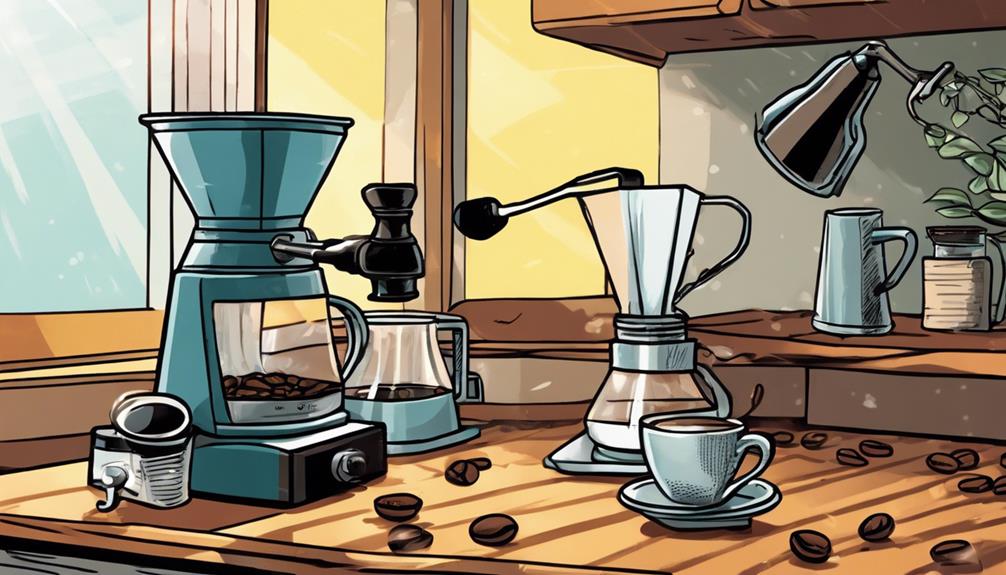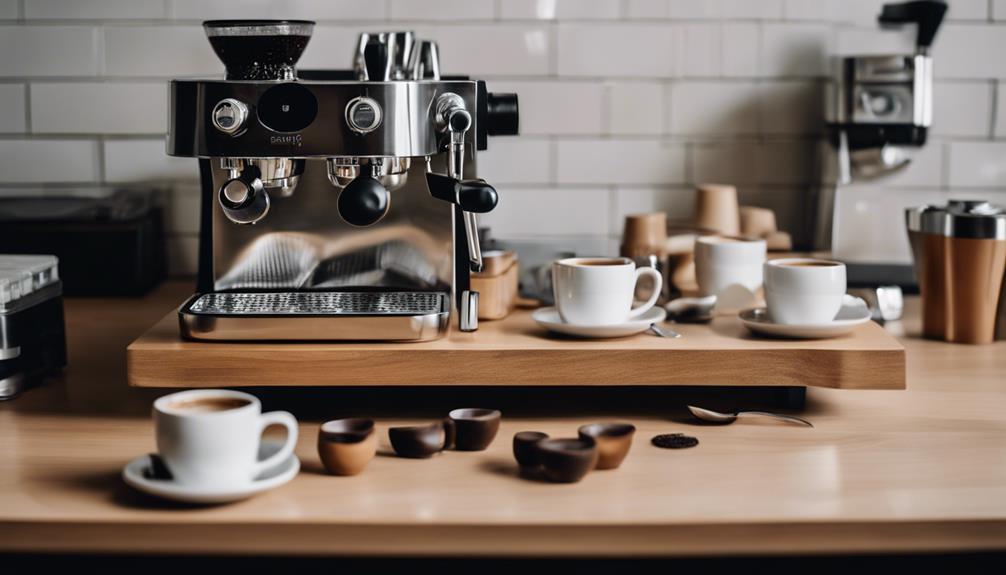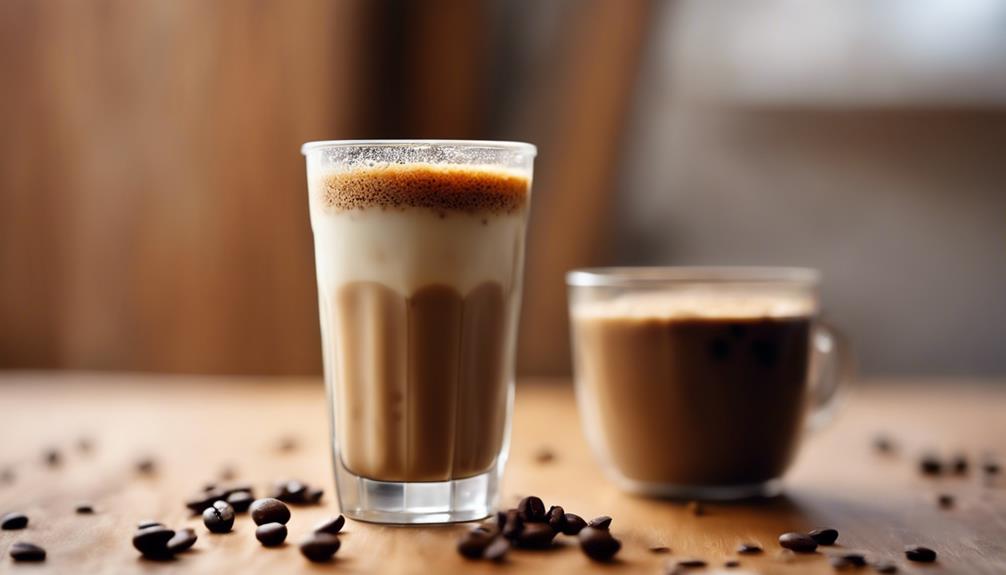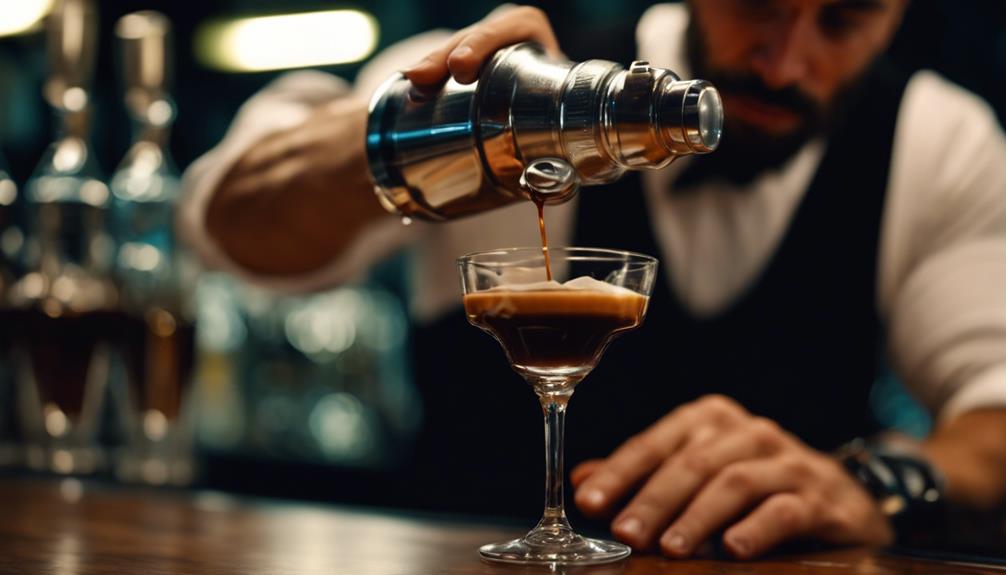You are on the verge of unlocking the secrets to making authentic Italian-style espresso using your Moka pot, just like grandma used to prepare. Begin by using freshly roasted coffee beans, ground to a medium-fine consistency to avoid any clogging, and correctly assemble the pot to ensure proper brewing. Fill the bottom part of the pot with cold water up to the safety valve and carefully monitor the brewing process over low to medium heat. Make sure the pot is sealed properly and turn off the heat once you hear a hissing noise. By following these crucial steps, you will soon be brewing rich and flavorful espresso just like an Italian – and there is even more to explore as you hone your skills.
Key Takeaways
- Use medium-fine ground coffee beans, specifically designed for Moka pots, for optimal flavor and aroma.
- Fill the bottom chamber with cold water up to the safety valve to prevent overfilling and ensure proper brewing.
- Monitor brewing on a flame no larger than the pot's diameter and turn off heat upon hearing hissing and seeing steam from the spout.
- Use freshly roasted and ground coffee for the best flavor, and store beans in an airtight container in a cool, dark place.
Moka Pot Essentials for Beginners
To get started with your Moka pot, it's vital to understand the basic components and how they fit together to brew a perfect cup of espresso-like coffee.
You'll need to familiarize yourself with the bottom water chamber, filter basket, and upper chamber. Make sure you assemble them correctly to avoid any leaks.
When it comes to coffee grounds, use medium-fine ground coffee in the filter basket, but don't pack it down. This will allow proper water flow and guarantee the best flavor. It's also important to use freshly roasted coffee beans specifically designed for Moka pots. The grind size should be similar to fine sand for peak extraction.
Remember to fill the bottom chamber with cold water up to the safety valve, and you're ready to start brewing. By following these simple steps, you'll be well on your way to brewing delicious espresso-like coffee with your Moka pot.
Step-by-Step Brewing Guide
With your Moka pot assembled and ready to go, it's time to fire up the stove and start brewing your espresso-like coffee.
Begin by filling the bottom chamber with water up to the safety valve level, making sure not to overfill. Next, insert the filter basket and fill it with medium-fine ground coffee, leveling off the top without pressing down the grounds to prevent clogging.
Here are three essential steps to keep in mind:
- Clean rim, perfect seal: Confirm there are no stray coffee grounds on the rim of the pot before screwing the upper section on tightly and straight.
- Monitor the brew: Place the assembled Moka pot on the stove over a flame no larger than the pot's diameter, monitoring the coffee as it starts to bubble and gurgle.
- Timing is everything: Turn off the heat once you hear a hissing sound and observe steam emerging from the spout, allowing the remaining coffee to percolate slowly until the upper chamber is full.
Coffee Selection and Grind Tips
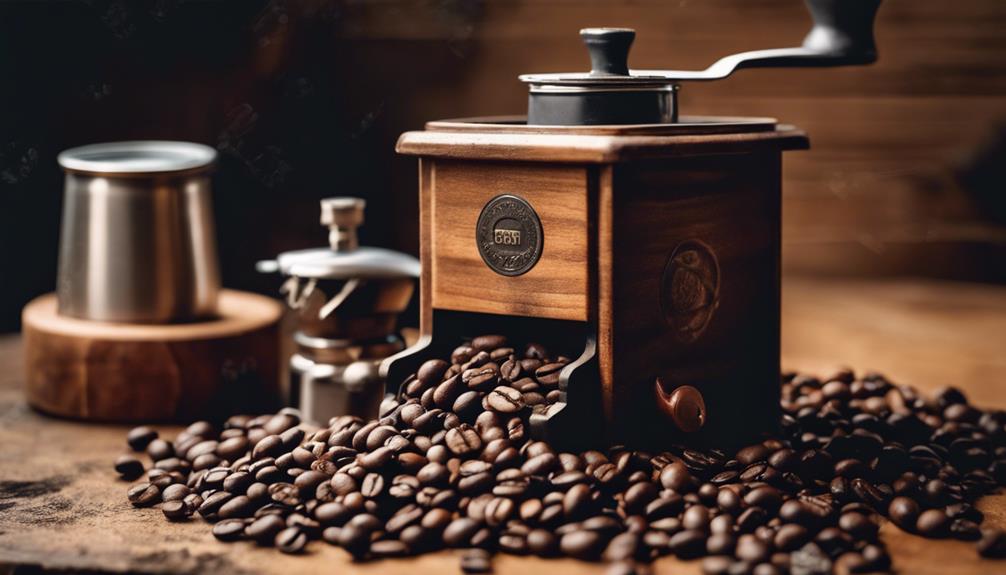
When it comes to brewing Moka pot espresso, you'll want to choose the right coffee beans and grind them just so.
You're looking for a medium roast blend that will give you a strong, aromatic flavor, and a grind size that's similar to granulated sugar.
Coffee Bean Selection
You'll get the best out of your Moka pot by selecting a medium roast blend of arabica and robusta coffee beans, which provides a balanced flavor profile that complements this brewing method. This blend will give you a rich and smooth coffee that's perfect for your Moka pot. Avoid using coffee beans that are specifically designed for drip coffee or espresso machines, as they may not produce the best results in your Moka pot.
When choosing your coffee beans, keep the following tips in mind:
- Opt for freshness: Use freshly roasted and ground coffee to guarantee ideal flavor and aroma.
- Experiment with blends: Try different coffee varieties and blends to discover unique flavor profiles that you enjoy.
- Store beans properly: Keep your coffee beans in an airtight container in a cool, dark place to maintain freshness and prevent flavor loss.
Optimal Grind Size
Selecting the ideal grind size is vital, as it directly impacts the flavor and quality of your Moka pot espresso. You'll want to aim for a medium-fine grind, similar to the consistency of table salt. This will guarantee rich flavor without clogging the filter.
Freshly grinding your high-quality beans specifically roasted for Moka pots is essential for the best flavor profile. Avoid using standard drip coffee or espresso blends, as they may be too coarse or fine, leading to poor brewing results.
When it comes to Italian coffee, the best grind size is critical. You'll notice that Italians are meticulous about their coffee, and grind size is no exception. Experimenting with different grind sizes and coffee types will help you discover your personal preferences.
Keep in mind that different beans and grinds can greatly enhance or alter the flavor experience. Remember, the ideal coffee-to-water ratio for a Moka pot is about 1:10, so adjust your grind size accordingly. By finding the perfect balance, you'll be brewing like an Italian in no time!
Perfecting the Brewing Process
To perfect the brewing process, fill the bottom chamber of your Moka Pot with cold filtered water up to the safety valve level, an essential step that guarantees proper brewing pressure. This guarantees that your Moka Pot coffee will be rich and full-bodied, just like the Italians make.
Next, use a medium-fine grind of coffee specifically roasted for Moka Pots, filling the filter basket without pressing down to avoid clogging and facilitate optimal extraction. Assemble the Moka Pot tightly, making sure no coffee grounds are on the rim to maintain a proper seal, which is vital to prevent leaks during brewing.
Here are three key takeaways to keep in mind when making espresso with your Moka Pot:
- Monitor the flame: Place the pot on a low to medium flame, monitoring for the distinct bubbling sound that indicates the coffee is brewing, and remove it from heat once the sound diminishes to avoid burning.
- Preheat your water: Preheat water before adding it to the Moka Pot, as this can reduce stovetop brewing time and enhance the overall flavor profile of the espresso.
- Tighten the seal: Secure a tight seal by assembling the Moka Pot correctly, which is vital for optimal brewing pressure and flavor.
Enhancing Flavor With Milk and Foam

When you're crafting the perfect Moka pot espresso, you're not just stopping at the coffee – you're thinking about the milk and foam that'll elevate it to the next level.
You'll want to master the art of creating silky textures, velvety foams, and unique flavor profiles that complement the rich taste of your Moka pot brew.
Milk Texture Matters
You're about to reveal the secret to velvety microfoam that elevates your Moka pot espresso experience, and it all starts with mastering the art of milk texture.
To achieve the perfect milk texture, you'll want to heat your milk to around 65-70°C (149-158°F) before foaming. This temperature range allows for the ideal formation of creamy bubbles.
Here are three key takeaways to keep in mind:
- Use the right milk: Whole milk is preferred for its rich, velvety texture, but you can experiment with alternatives like oat or almond milk for different flavor profiles.
- Aerate with care: Introduce air while steaming to develop creamy bubbles, but be gentle to avoid creating large, unwieldy bubbles.
- Let it settle: Allow the foam to settle for a few seconds before pouring it into your Moka pot coffee, which helps create a denser texture and enhances the overall mouthfeel.
Foam Creation Essentials
Now that you've mastered the art of milk texture, it's time to explore the world of foam creation, where the perfect balance of heat, air, and flavor integration can elevate your Moka pot espresso experience to new heights.
To create the perfect foam for your espresso drink, heat milk separately before frothing to achieve the best texture and flavor integration. Use a milk-foaming mug or French press to froth milk, aiming for a temperature of around 60-65°C (140-149°F) for ideal foam consistency.
Allow the foam to settle for a few moments before adding it to your brewed Moka Pot coffee to guarantee a denser, creamier texture.
Feel free to experiment with different milk types, such as whole, skim, or plant-based options, to find a flavor profile that complements your Moka coffee best.
You can even add a twist by incorporating spices like cinnamon or vanilla into the milk before frothing to enhance the overall flavor of your espresso drink.
With these foam creation essentials, you'll be well on your way to crafting exceptional Moka Pot espresso drinks that will impress even the most discerning palates.
Enhancing Flavor Profiles
As you explore the world of Moka Pot espresso, you'll find that expertly crafted milk and foam can elevate your drinks from ordinary to extraordinary, revealing a rich tapestry of flavors and textures that will tantalize your taste buds.
To take your Moka Pot espresso to the next level, focus on enhancing flavor profiles by experimenting with different milk types and foaming techniques.
Here are three essential tips to get you started:
- Preheat your milk: Before frothing, heat your milk separately to achieve a denser, more velvety foam that complements the robust taste of Moka coffee.
- Experiment with milk types: Try using whole, oat, or almond milk to discover unique flavor profiles that pair well with the strong, aromatic notes of Moka Pot coffee.
- Add a twist with spices: Introduce additional layers of flavor by adding spices like cinnamon or cardamom to your milk before foaming.
Cleaning and Maintenance Tips
To keep your Moka pot espresso brewing at its best, disassemble it after every use and give each component a thorough cleaning. You'll want to break down the Moka pot into its bottom chamber, filter basket, and upper section to get rid of any coffee residue buildup. Rinse all the parts with hot water, but avoid using soap, as it can leave behind unwanted residues that'll affect the flavor of your next brew.
Regularly inspect the rubber gasket for signs of wear or damage, and replace it if needed. This'll guarantee a proper seal and prevent any leaks during brewing. When you're done cleaning, store your Moka pot in a dry place to prevent corrosion. Make sure all the components are completely dry before reassembling to maintain peak performance.
Don't forget to clean the spout and filter basket with a soft brush or cloth to remove any coffee oils or residue. This'll guarantee a clean brewing experience for future use. By following these simple cleaning and maintenance tips, you'll be able to enjoy delicious Moka pot espresso for years to come.
Moka Pot History and Cultural Significance

Step into the rich history of the Moka Pot, a stalwart of Italian coffee culture that has been brewing espresso-like coffee in homes since 1933. You're about to uncover the fascinating story behind this iconic stovetop brewer.
Patented by Alfonso Bialetti, the Moka Pot revolutionized home coffee brewing, making it accessible to the average household. Today, it's a symbol of Italian coffee culture, found in a staggering 90% of Italian homes.
Here are three reasons why the Moka Pot is synonymous with Italian hospitality:
- Family gatherings: The Moka Pot is often at the center of family gatherings, fostering social interactions and shared experiences.
- Cultural connection: The name 'Moka' is derived from Mokha, Yemen, a historical coffee production region, emphasizing the cultural connection between Italy and the origins of coffee.
- Innovative design: The Moka Pot's design was inspired by a household laundry apparatus, showcasing the innovative use of steam pressure in everyday kitchen tools.
As you explore the world of Moka Pot espresso, remember that you're not just brewing coffee – you're participating in a rich cultural tradition that's been passed down through generations of Italians. In Italy, the Moka Pot holds a special place in the hearts of coffee enthusiasts, and using it to brew espresso is seen as an art form. The rich, intense flavor of Moka Pot espresso has even made its way into modern cocktail culture, with many bars incorporating it into their menu as a key component in espresso martini ingredients. So, next time you brew a pot of Moka Pot espresso, take a moment to savor not just the coffee, but the rich history and tradition behind it.
Common Misconceptions and Troubleshooting
You're about to debunk some common myths and troubleshoot issues that might be holding you back from brewing the perfect Moka Pot espresso.
One common misconception is that Moka pot coffee is the same as true espresso, but it's not. Moka pots use steam pressure, which results in a different flavor profile.
To make the best Moka pot espresso, avoid overfilling the water chamber, as this can cause coffee leaks and improper brewing. Fill the bottom chamber up to the safety valve level for ideal results.
Using the right grind size is essential – a medium grind is ideal, as too fine can clog the filter and too coarse may result in weak coffee.
Don't heat your Moka pot on high flame, as this can burn the coffee; instead, use a low to medium flame for a more flavorful extraction.
Finally, if your coffee tastes bitter, it may be due to over-extraction. Turn off the heat as soon as the gurgling sound begins, indicating that brewing is complete.
Experimenting With Coffee Ratios and Blends
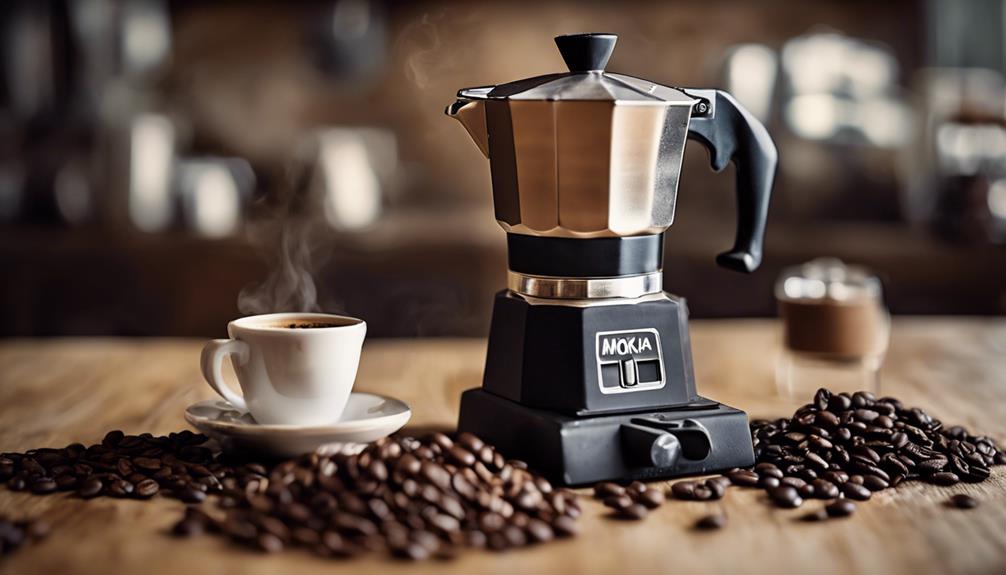
As you start experimenting with coffee ratios and blends, you'll soon discover that even small adjustments can greatly impact the flavor of your Moka pot brew.
You'll want to try different coffee-to-water ratios, like 1:12 or 1:18, to find the perfect balance of strength and flavor for your taste buds.
Coffee Ratio Experimentation
Experiment with coffee ratios and blends to reveal the full potential of your Moka pot espresso, and discover the perfect balance of flavors that suits your taste buds.
You're not limited to a single ratio, and adjusting the coffee-to-water ratio can greatly alter the flavor profile. A common starting point is 1:7, but feel free to experiment to find your perfect balance.
Here are some tips to keep in mind when experimenting with coffee ratios:
- Start with a base: Begin with a standard ratio and adjust from there to find your perfect balance.
- Grind size matters: A medium-fine grind is recommended for best results, allowing for a rich and aromatic cup without clogging the filter.
- Track your variations: Keep track of changes in brewing time, temperature, and coffee ratios to fine-tune the brewing process and achieve the desired taste and strength.
Moka Pot Blend Options
Now that you've found your ideal coffee-to-water ratio, it's time to explore the world of Moka pot blend options, where the perfect balance of flavors awaits.
Experimenting with coffee ratios can greatly enhance the flavor of your Moka pot brew. A common starting point is a blend of 70% Arabica for smoothness and 30% Robusta for added richness and crema. You can also try adjusting the grind size to fine-tune the flavor; a medium-fine grind is typically recommended, but feel free to experiment with finer or coarser grinds to suit your taste.
For a unique twist, incorporate spices like cinnamon or cardamom into your coffee blend to complement the rich notes of the Moka coffee. Mixing different roast levels, such as combining a light roast for acidity with a dark roast for body, allows you to create a personalized flavor profile tailored to your palate.
Remember to always use freshly ground coffee beans, as their oils and flavors are best preserved when ground just before brewing. This guarantees the coffee's aromatic qualities shine through in your Moka pot brew.
Flavor Profile Tweaking
Your journey towards crafting the perfect Moka pot espresso begins with tweaking the flavor profile, which relies heavily on experimenting with coffee ratios and blends that resonate with your taste buds.
To get started, try adjusting the coffee-to-water ratio, aiming for a balanced flavor profile. A good starting point is a 1:15 ratio, but feel free to experiment to suit your taste.
Here are three key factors to take into account when tweaking your flavor profile:
- Coffee blend: Mixing different beans can enhance the richness and depth of flavor. Try combining 70% Arabica for sweetness and 30% Robusta for body.
- Grind size: Adjusting the grind size can notably impact the flavor. A slightly finer grind can increase extraction, while a coarser grind may produce a lighter flavor.
- Roast level: Medium roast coffees with nutty or chocolatey notes often complement the Moka pot's brewing method well, resulting in a more pronounced flavor.
Remember to keep track of brewing times and water temperatures, as slight variations can influence the final flavor.
With a little experimentation, you'll be well on your way to crafting a Moka pot espresso that's tailored to your taste preferences.
Mastering the Art of Italian Espresso
Master the art of Italian espresso by perfecting your brewing technique, as it's the key to revealing the rich, velvety flavors and aromas that define this beloved coffee tradition.
To brew authentic Italian espresso using a Moka pot, start with freshly ground coffee beans, ideally a medium-roast blend of arabica and robusta, ground to a fine sand consistency for ideal extraction. Next, fill the bottom chamber of the Moka pot with cold water up to the safety valve, then insert the filter basket and fill it with the finely ground coffee. Screw the top and bottom chambers together securely, and place the Moka pot on the stovetop over medium heat. As the coffee brews, you’ll notice a rich aroma and a bubbling sound – the hallmark of authentic Italian espresso. Once the top chamber is filled with brewed espresso, remove the Moka pot from the heat and serve the espresso immediately. The Bialetti espresso maker is one of the most well-known and trusted brands for Moka pots, and using one can help guarantee a perfect cup of Italian espresso every time. With the right technique and equipment, you can enjoy the rich, bold flavor of authentic Italian espresso in the comfort of your own home.
For an alternative use of your espresso, consider using it as one of the espresso martini ingredients to create a delicious cocktail. Simply combine the freshly brewed espresso with vodka, coffee liqueur, and simple syrup in a shaker with ice, and strain into a martini glass for a sophisticated and energizing drink.
Fill the bottom chamber of the Moka pot with filtered water up to the safety valve and place the coffee grounds in the filter basket without pressing them down to prevent clogging.
Heat the assembled Moka pot over low to medium flame, listening for the initial bubbling sound that indicates brewing, and remove it from heat once the sound diminishes to avoid burning the coffee.
Serve the brewed espresso in small ceramic cups, preheating them in hot water to retain warmth and enhance the drinking experience.
You can further enhance your Moka pot espresso by experimenting with adding spices like cinnamon or cardamom, or by creating a creamy texture through proper mixing techniques with sugar.
Frequently Asked Questions
How Do Italians Use Moka?
You're wondering how Italians use Moka pots? Well, they make it a daily ritual, brewing caffè all'italiana in small ceramic cups, often with sugar, and savoring the rich flavors of medium-roast blends in a cherished family tradition.
How Do They Make Espresso in Italy?
You'll find Italians brewing espresso with high-quality beans, finely ground to sugar-like consistency, using traditional machines or moka pots, and carefully serving it in preheated cups to preserve the perfect temperature and rich flavor.
What Do Italians Call a Moka Pot?
You're wondering what Italians call a Moka Pot? Well, you'll fit right in with the locals if you start calling it a "caffettiera" or "caffettiera moka", just like the 90% of Italian households that own one!
How Do You Make Good Espresso With Moka?
You make good espresso by filling the Moka pot with filtered water, using freshly ground coffee, assembling it securely, and brewing on low heat, then serving immediately in small ceramic cups.
Conclusion
With every rich, velvety shot, you're now a master of the Moka pot, effortlessly extracting essence from expertly ground beans.
Your daily dose of dopamine now comes with a dash of Italian flair, as you finesse the froth and flaunt your freshly brewed creations.
Fearless and fanatic, you'll continue to finesse, experimenting with flavors and ratios, forever fascinated by the fusion of art and science in every perfect pour.
